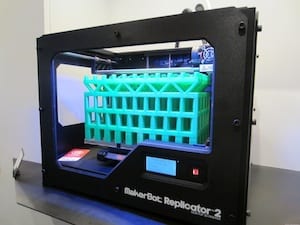In 2009, the movie “Avatar” established 3D as a major force in the film industry, but elsewhere it’s been slow to become mainstream. Yet a couple of new 3D technologies — 3D printing and scanning, in particular — pose big impacts for the field service industry, and could revolutionize parts production and inventory management. We’ll see how long it takes to catch on, but one thing they’ve got going for them: No glasses needed.
3D Printing: Produce Your Own Parts

It’s not so much a printer as it is a magic box that can create nearly any object. 3D printers pile thin layers of materials — acrylic, nylon and more. — on top of each other to create just about anything you can imagine.
Take, for example, a tech who is out in the field inspecting a busted cooling fan in an AC unit. Instead of having to order a replacement part, which can take days or weeks, a tech with a 3D printer in his van could, within minutes, actually create the specific part on-site. No more having to go through a warehouse, searching through inventory logs or having to tell a customer “the part’s been ordered and should arrive in 5-7 days.”
The ability for a tech to build and fix a part on-site would undoubtedly lead to quicker fix times, smaller inventory requirements and ultimately money saved. It also could lead to more customized parts and solutions.
3D printing is still in its infancy and not yet used for much more than creating basic consumer goods — though there are now 30,000 people walking around with 3-D printed titanium hips, according to NPR’s Planet Money.
3D Scanners: A Second — And Better — Set of Eyes

3D scanners are already making inroads in field service. The scanner is no more than a wireless handheld 3D imaging device that looks similar to the barcode scanners you see at most retail shops. Yet it allows techs in the field to get a close look at the inner workings of just about anything — and better diagnose issues.
By simply running the scanner over the equipment in question, a tech receives a 3D image of the part and can assess the problem without getting his hands dirty. Knowing what needs to be fixed before opening up layers and layers of a complex machine can certainly prevent a lot of headaches and lost time.
Read more: Motorola HC1: The Field Tech’s First Wearable Computer

Share this: